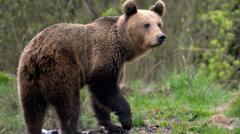In the affluent enclave of Nordelta, located north of Buenos Aires, residents have found themselves facing an unexpected issue: an overwhelming population of capybaras, the world’s largest rodent. With their heavy bodies and calm demeanor, capybaras have charmed animal lovers and internet users alike, becoming stars in adorable videos. However, this burgeoning love for the creatures has resulted in a serious ecological dilemma for local communities.
Luciano Sampietro, a veterinarian versed in wildlife management, recently employed a blow dart to sedate a large capybara to prepare it for sterilization. The tranquil setting by an artificial pond, where these rodents often lounge, seems far removed from the complexities involved in managing their rapidly growing numbers. Each sedated rodent is treated with care, but the urgency remains: with some females already pregnant, the city has taken bold steps to curb reproduction rates.
Nordelta’s expansion has encroached upon natural habitats, effectively converting spaces that used to harbor wildlife into luxury golf courses and residential areas. Satellite images showcase this environmental transformation, illustrating the repercussions of urban expansion on local wildlife habitats. As capybaras seek refuge in the increasingly urban landscape, their presence conflicts with the desires of residents, who consider them both a nuisance and a point of unique charm.
Efforts to manage wildlife populations, especially in a community affluent with resources, have paved the way for sterilization programs intended to stabilize the capybara numbers. Despite their popularity, complaints among residents highlight the unique challenges of cohabitating with wildlife in suburban settings. As Nordelta's residents navigate the balance between appreciating and managing these social media darlings, they spark a broader discussion on human-wildlife interactions in modern environments.
Luciano Sampietro, a veterinarian versed in wildlife management, recently employed a blow dart to sedate a large capybara to prepare it for sterilization. The tranquil setting by an artificial pond, where these rodents often lounge, seems far removed from the complexities involved in managing their rapidly growing numbers. Each sedated rodent is treated with care, but the urgency remains: with some females already pregnant, the city has taken bold steps to curb reproduction rates.
Nordelta’s expansion has encroached upon natural habitats, effectively converting spaces that used to harbor wildlife into luxury golf courses and residential areas. Satellite images showcase this environmental transformation, illustrating the repercussions of urban expansion on local wildlife habitats. As capybaras seek refuge in the increasingly urban landscape, their presence conflicts with the desires of residents, who consider them both a nuisance and a point of unique charm.
Efforts to manage wildlife populations, especially in a community affluent with resources, have paved the way for sterilization programs intended to stabilize the capybara numbers. Despite their popularity, complaints among residents highlight the unique challenges of cohabitating with wildlife in suburban settings. As Nordelta's residents navigate the balance between appreciating and managing these social media darlings, they spark a broader discussion on human-wildlife interactions in modern environments.


















